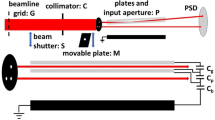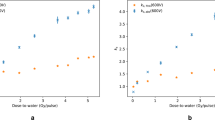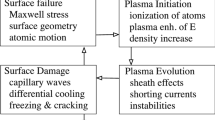Abstract
Taylor and Singer1 placed a system of parallel guard wires around the inter-electrode space of a ‘free-air’ ionization chamber, the wires being maintained at potentials evenly graded between those of the collecting electrode and the high-voltage electrode respectively. Electrostatic field distortion (largely arising from the proximity of the earthed casing) was thereby diminished, enabling the chamber dimensions to be reduced—an important factor in a chamber designed for portability. However, the guard wires, taken together, comprise a relatively inefficient screening and field-shaping system2, and we have investigated a guard strip system, a cross-section through the mid-plane of a typical free-air chamber incorporating this system being as shown in Fig. 1. AA′, BB′, CC′, etc., are the sections of rectangular metal (or graphited plastic) frames, which pass along both sides of the chamber and across the ends, except for small apertures in the ends of the central one (or the central pair, as the case may be), permitting the passage of the X-ray beam. The width w of each of the frames is large compared with the gap g between consecutive frames. Thus w might be, say, 4 cm., and g 4 mm. only. The upper and lower electrode systems E and E′ have an edging of width ½w, as shown. Equal potential differences are maintained across all the gaps g. It is easily seen that in those circumstances the horizontal planes (represented by aa′, bb′, cc′, etc.) bisecting each frame, together with the upper and lower electrodes E and E′, constitute equi-spaced, equipotential planes. The associated lines of force are somewhat as indicated. It has been found by electrolytic tank studies that these lines (namely, LM and PQ) have become quite straight at a distance d from the guard strips, where d is approximately ¾w. The guard system is thus seen to be a very efficient one, enabling particularly compact chambers to be constructed.
This is a preview of subscription content, access via your institution
Access options
Subscribe to this journal
Receive 51 print issues and online access
$199.00 per year
only $3.90 per issue
Buy this article
- Purchase on Springer Link
- Instant access to full article PDF
Prices may be subject to local taxes which are calculated during checkout
Similar content being viewed by others
References
Taylor, L. S., and Singer, G., Radiology, 15, 637 (1930).
Kemp, L. A. W., and Hall, S. M., Brit. J. Radiol., 27, No. 316, 219 (1954).
Author information
Authors and Affiliations
Rights and permissions
About this article
Cite this article
KEMP, L. Guarded-Field Ionization Chambers: a New Principle applied to both Free-Air and Thimble Versions. Nature 178, 1250–1251 (1956). https://doi.org/10.1038/1781250a0
Issue Date:
DOI: https://doi.org/10.1038/1781250a0
This article is cited by
-
Guarded-Field Thimble Ionization Chambers
Nature (1957)
Comments
By submitting a comment you agree to abide by our Terms and Community Guidelines. If you find something abusive or that does not comply with our terms or guidelines please flag it as inappropriate.



